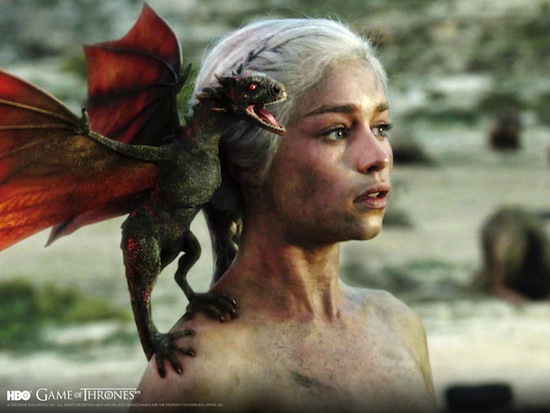About a year ago, The New York Times published an utterly dismissive review of HBO's Game of Thrones written by Ginia Bellafante, a female writer who, among other things, found the series lacking any appeal for women. Following the success of the show and, perhaps, the relative backlash generated by the article—including from female fans and writers—the Times' review this year is clearly less disdainful, but is not quite conciliatory. Written by Neil Genzlinger, the review shares the same categorization of the typical audience of the show, the “Dungeons & Dragons types.” Even if at this point in the series that is a sweeping generalization, I believe it might be a sign of troubles to come.
The first season of the HBO series told the story of A Game of Thrones, the first book in G.R.R Martin's book series, A Song of Ice and Fire. Aside from a hint at the very beginning at some unorthodox things happening beyond the Wall, season one was remarkably devoid of any magic or anything fantasy-like, until Daenerys Targaryen's dragons hatched at the very end.

Epic or high fantasy—not to be confused with supernatural (as a genre) or horror, or any of the other fantastical fiction genres or subgenres—requires an imaginary world, magic and otherworldly beings among which we often, but not always, have dragons. It took nearly 50 years for the work many consider as the first true representative of the epic fantasy genre (Tolkien's The Lord of the Rings) to be adapted to the big screen. The Lord of the Rings movies, released from 2001 to 2003, came out as our TVs were being invaded by shows under the bigger umbrella of the speculative (read fantastical) fiction genre, from Xenia: Warrior Princess to Buffy the Vampire Slayer, so we could argue that audiences were ready, but were they?
In a world where fantasy books are often topping bestseller lists and TV networks are overcrowded with productions in related categories and subcategories, The New York Times’ articles reminds us of important differences between all those genres. Epic fantasy is dominated by its medievalist form where the roles of men and women in the society at large are not quite like today, and where—according to the genre's detractors—sex, nudity and violence is often depicted in a, well, "medieval" way. What's more, while many adults today might be used to seeing vampires, werewolves, and succubae roam our streets in modern urban fantasy/supernatural stories, a fire-breathing dragon might conjure up images of children stories, which brings us back to Game of Thrones.
From the geography of the continent of Westeros to the story about the different families vying for control of the seat of power at King's Landing, the story has been so far more reminiscent of England during the War of the Roses than of a "true" epic fantasy story. However, the story has gradually included some traces of magic, and has brought three dragons to life. Their very existence will now be a constant reminder to viewers that they are watching an epic fantasy.

Looking back, besides The Lord of The Rings movies (which are obviously not a TV series), the only true parallel to Game of Thrones is Legend of the Seeker, the first syndicated show (not produced for a specific network) based on Terry Goodkind's book series, The Sword of Truth. Legend of the Seeker premiered in 2008 and was cancelled after only two seasons, which doesn't bode well for Game of Thrones, especially considering that The Sword of Truth sold more than three times what A Song of Ice and Fire has achieved so far. However, it should be said that despite having a much wider (local station) reach than Game of Thrones which is restricted to a premium cable channel, Legend of the Seeker's best Nielsen TV ratings (for adults aged 18-49) was well below 2.0, the rating reached by the HBO's series on its second season premiere on April 1, 2012.
The show premiered in April 2011 with 2.22 million viewers and consistently improved until the record 3.84 million viewers of the season two premiere a few days ago. Apparently, the sex, violence, incredibly male-dominated society and multiple storylines, as well as the myriad of characters didn't deter the mixed audience throughout the first season.
All that brings us back to dragons, which, to me, represent the untested aspects of epic fantasy on a mixed (male/female) adult TV audience. The Lord of the Rings movies got their balrog out of the way in the very first scenes and Legend of the Seeker didn't really have any otherworldly creature of any significance. Game of Thrones has dragons that will be around each time Daenerys and her Dothrakis are featured, not to mention that they might possibly be key players at some point. Will the series survive the story gradually embracing its epic fantasy roots so openly?
The first test was apparently successful. The season one finale had 3.04 million viewers and the second season premiere improved on that by almost one million viewers, including many (like me) who only discovered the world of Westeros with the HBO series. It seems baby dragons have not repelled the audience, but will they (and the growth of magic that comes with them) stay cute and irrelevant—as far as the ratings are concerned—for the remainder of the series?